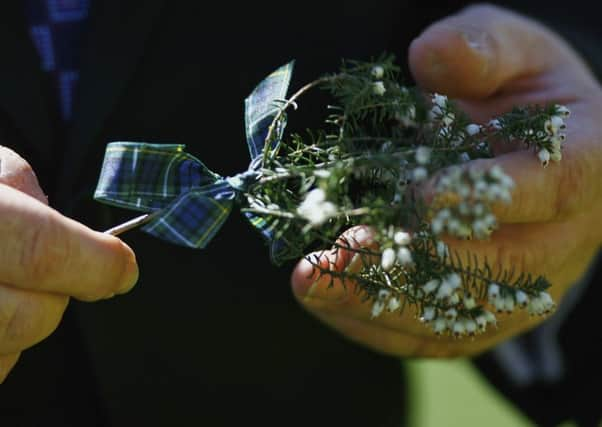Friday 13th: Scotland’s strangest old superstitions


Superstitions are powerful. Even if you don’t believe in them, they’ve shown a lot of staying power. Many superstitions date back to pagan times, and, in some form, they’re still around today - just as many other customs from the pre-Christian period have died out. Some of them pop up in everyday conversations - ”touch wood”, for example - while others are still adhered to, unconsciously or otherwise (even if you don’t believe that walking under a ladder will bring bad luck, you’d probably still avoid it; a smashed mirror, as well as bringing seven years of bad luck, would be a pain to clean up).
Scotland has a unique set of superstitions - some well known, others less so. Since superstitions exist to give protection to the things we hold dear, a majority of them concern the shielding of family members - especially children - from harm.
Children
Advertisement
Hide AdUntil fairly recent history, childbirth was a perilous ordeal for Scottish women - and, therefore, a minefield of superstitions (only some of which are mentioned here, for the sake of brevity). Some thought that rocking an empty cradle would enhance a woman’s fertility (“If you rock the cradle empty / Then you will have babies plenty”). Others, though, thought that doing this was actually bad luck, and would bring about a baby’s death. The cutting of childrens’ nails and hair was approached warily - clippings of both were sought by witches as ingredients for spells.
Strangest of all, perhaps, was the practice of the “teethin’ bannock”. To cure a child of teething troubles, it would be given a bannock - a flat, round loaf of bread - to play with until a piece broke off, which would then be fed to them (others present in the room would eat a piece, too). This practice was written about in F Marian McNeill’s The Scots Kitchen, published in 1929.
Howdies - a type of midwife - were a crucial presence in the act of childbirth until the 1950s. They ensured various superstitions were adhered to in safeguarding a newborn’s safety (untying knots, turning over mirrors, unlocking doors and windows, among other things). Even more esoteric rituals took place after birth: babies were given whisky (!) to ward off evil spirits, and then fed a mixture of oatmeal and water to give them strength.
Also prevalent up until that period was handselling. Handselling is a gift-giving gesture intended to bring good luck to its recipient as a celebration of a new event - in many cases, a baby. Infants were often handed silver coins by friends of the family. How they handled the coin would determine how they would manage their finances in the future (grabbing the coin tightly would foretell penny-pinching; dropping the coin promised lavish spending). Giving a silver coin to a baby was also believed to bring wealth to a child in later life.
Black sheep
Being a black sheep of the family is an idiom with origins in the north of Scotland. Farmers believed that the birth of a black sheep spelled doom for the remainder of the flock. The colour black also had strong negative connotations with the devil, compounding the superstition. The difficulty of dyeing a black sheep’s fleece made it much less valuable, as well. All in all, they were pretty unwelcome - hence the proverb.
FOLLOW US
SCOTSMAN TABLET AND MOBILE APPS
Umbrellas
The bad fortune feared after the opening of an umbrella indoors dates back to ancient Egypt, but it’s no surprise that - given our climate - the superstition took hold in Scotland. Opening a brolly in a Scottish household is said to bring bad luck to those who live there (even if the person opening it is a stranger or otherwise unrelated).
Advertisement
Hide AdMost accounts speculate that the origin of the superstition arose from a fear of offending various sun gods (not a problem here in Scotland, of course), who would perceive the act as an insult. In a contemporary sense, practical considerations come into play here too: opening an umbrella in a house is, well, pretty daft. At best, you’ll look silly; at worst, you’ll take someone’s eye out.
White heather
Superstitions surrounding white heather have been around for centuries. A folk tale about Malvina, daughter of Celtic bard Ossian whose lover, Oscar, died in battle, gives us an insight into why the plant is considered lucky. According to the story, Malvina’s tears fell on purple heather delivered by Oscar’s messenger as a token of her late partner’s love - the heather then turned white as a result. She then said: “May the White Heather, symbol of my sorrow, bring good fortune to all who find it.” Its subsequent association with providing good fortune in battle has propped up white heather’s reputation as a lucky charm.
Advertisement
Hide AdQueen Victoria helped popularise white heather’s fortune-giving properties by writing of her servant and constant companion, John Brown: “[he] espied a piece of white heather, and jumped off to pick it. No Highlander would pass by it without picking it, for it was considered to bring good luck.”
To this day, white heather persists as a lucky charm. Grooms will wear a sprig of it as part of their wedding outfit.